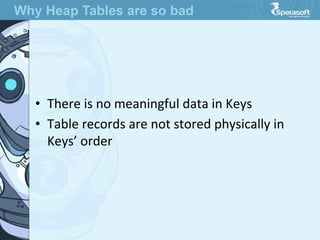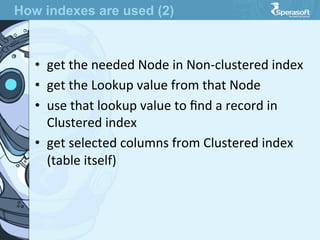Database Indexes
- 2. Who We Are? We are a team of professionals specializing in game development, art production, online engineering and creation of amazing products. Our technology competencies include solid experience and background in delivering scalable platforms and online solutions. That serve millions of players all over the world and run beyond amazing games. Read more: http://www.sperasoft.com
- 3. • RDBMS store data only in Trees • Index is a tree in terms of data structure • a Table is an Index • a Clustered Index is a Table itself • a Non-‐clustered Index is a copy of data • all Non-‐clustered Indexes refer to Clustered one • all keys in Tree Nodes are always unique The Simple Truth
- 4. • Oracle Database • SQL Server • IBM DB2 • MySQL • PostgreSQL • Sybase • Informix What’s Common Between
- 5. RDBMS is a type of Database Management System that stores data in the form of related tables RDBMS is a Database Management System that is based on the relaJonal model introduced by E.F. Codd Data is stored in tables and the relaJonships among the data are also stored in tables Relational Database Management Systems
- 6. • Born on the Isle of Portland in England in 1923 • Died in Florida US in 2003, aged 79 • MathemaJc • Worked for IBM Edgar Frank “Ted” Codd
- 7. • Introduced “A RelaJonal Model of Data for Large Shared Data Banks” and Alpha database language • IBM started implemenJng the RelaJonal model and introduced another language named SEQUEL Edgar Frank “Ted” Codd
- 8. • Larry Ellison came up in Jme with his implementaJon of RelaJonal model and the language – Oracle Database and SQL • ANSI started making SQL standard Birth of Oracle
- 9. • It’s all about Table RelaJons Relation Model Briefly
- 10. • Database contains tables (two dimensional arrays) • Tables have relaJonships enforced by Foreign Key constraints (1-‐to-‐Many relaJonship) • NormalizaJon of tables is a key concept • That’s why RDBMS are called RelaJonal Relation Model
- 12. • Files are flat in nature FILE READING CURSOR 0 OFFSET All Tables Are Stored in a File
- 13. • What’s the value behind relaJons? • What is a database table? • What is a table index? • RelaJons vs How data is stored What’s Actually Matter
- 14. Id User Name Country City Age 1 Michael USA Boston 30 2 Jane USA Boston 24 3 Scoe USA NYC 18 4 Bob UK London 41 5 Prescoe UK London 35 • Such array seems to be a table • How to find Users from Boston faster? ArrayList<User> users = new ArrayList<User>(); How to Handle Millions of Users
- 15. Boston 1, Michael, USA, Boston, 30 2, Jane, USA, Boston, 24 NYC 3, Scoe, USA, NYC, 18 London 4, Bob, UK, London, 41 5, Prescoe, UK, London, 35 Index is a Tree
- 16. ID = 2 2, Jane, USA, Boston, 24 ID = 1 1, Michael, USA, Boston, 30 ID = 3 3, Scoe, USA, NYC, 18 Can replace an initial array with Index
- 17. • Key values in a Key node should be unique • Otherwise Trees do not work What’s important to note
- 18. • Indexes are Trees in terms of data structure • Trees are suitable to store any array of data to make search faster Returning to our sheep
- 19. • All RDBMS store data as Balanced Trees • The concrete implementaJon of B-‐Tree could differ from vendor to vendor • It means the only way to store data is Tree • No excepJons here -‐ table is a tree, index is a tree Balanced Trees
- 20. What’s a Clustered Index
- 21. • The next record in Clustered Index is always stored aoer the previous one RECORD 1 RECORD 2 1 | Michael | USA | Boston | 30 2 | Jane | USA | Boston | 24 The clustered index storage
- 22. Have a quesKon? Like this deck? Tweet us @SperasoR Like deck on SlideShare.com/sperasoR
- 23. • Clustered Indexes • Non-‐clustered indexes • Both could be unique and non-‐unique • Table can be without any indexes • How is that comply with how data is actually stored? What SQL allows us to do
- 24. • Unique and non-‐unique • CREATE CLUSTERED INDEX [name] ON [table_name] ([column1], [column2]) • CREATE UNIQUE CLUSTERED INDEX [name] ON [table_name] ([column1], [column2]) Clustered Indexes
- 25. • Unique and non-‐unique • CREATE NONCLUSTERED INDEX [name] ON [table_name] ([column1], [column2]) • CREATE UNIQUE NONCLUSTERED INDEX [name] ON [table_name] ([column1], [column2]) None Clustered Indexes
- 26. ID = 2 Jane, USA, Boston, 24 ID = 1 Michael, USA, Boston, 30 ID = 3 Scoe, USA, NYC, 18 Unique Clustered Index
- 27. • We know Key values should be unique • How RDBMS resolves this problem? Non-unique Clustered Index
- 28. • SQL Server adds 4-‐byte uniquifier to each duplicated key value • Algorithms could differ from vendor to vendor • But the principle is the same – add something to make them unique Non-unique Clustered Index
- 29. • Just omitng Unique keyword makes Key values bigger (why it’s bad realize later) • The simple truth is that Each table should have Clustered Index • The Clustered Index should be always Unique • The situaJons when its not so should be excepJonal Clustered Indexes
- 30. • Such tables are called Heap Tables • How are they stored in database if they do not have a Key value specified? Tables without Clustered Index
- 31. • Heap Tables are also stored in Trees • What’s in a Key value for Tables without Clustered Index? • The value called RID • the unique idenJfier which refers to the physical locaJon of the record in a file No magic over here
- 32. • There is no meaningful data in Keys • Table records are not stored physically in Keys’ order Why Heap Tables are so bad
- 33. • Clustered Index has the actual data columns in Leaf-‐ nodes • What’s in Leaf-‐node of Non-‐clustered index? • Remember that Non-‐clustered Indexes are duplicated data Non-clustered Indexes
- 34. Jane Lookup value: ID=2 Michael Lookup value: ID=1 Scoe Lookup value: ID=3 • Leaf-‐nodes contain the lookup values • Lookup value is Clustered Index’s Key Non-clustered Index
- 35. • We know Key values should be unique • How non-‐clustered index’s key becomes unique? Non-unique Non-clustered Index
- 36. • SQL Server adds Clustered Index Key value to Non-‐clustered Index Key value to make it unique Jane, 2 Lookup value: ID=2 Michael, 1 Lookup value: ID=1 Scoe, 3 Lookup value: ID=3 Non-unique Non-clustered Index
- 37. • from SELECT statement the WHERE condiJon is taken • based on the Columns in WHERE we know what columns we search by • look through available indexes trying to find the appropriate one, starJng from Clustered • found out non-‐clustered index which fits best How indexes are used (1)
- 38. • get the needed Node in Non-‐clustered index • get the Lookup value from that Node • use that lookup value to find a record in Clustered index • get selected columns from Clustered index (table itself) How indexes are used (2)
- 39. • Unique Clustered Index on Id column • Non-‐unique Non-‐clustered Index on City column • Select UserName from tbl where City = ‘Boston’ Sample 1
- 40. • Unique Clustered Index on Id column • Non-‐unique Non-‐clustered Index on City column • Select Id from tbl where City = ‘Boston’ Sample 2
- 41. • Unique Clustered Index on Id column • Non-‐unique Non-‐clustered Index on City column • Select UserName from tbl where City = ‘Boston’ select should not go to Clustered Index Sample 3
- 42. • Unique Clustered Index on Id, UserName column • Select Id from tbl where City = ‘Boston’ and UserName = ‘Michael’ • What columns Non-‐unique Non-‐clustered Index would include? Sample 1
- 43. WE ARE SPERASOFT DELIVERING AMAZING PRODUCTS Follow us: @SperasoA hCp://www.sperasoA.com




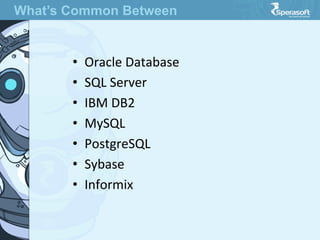

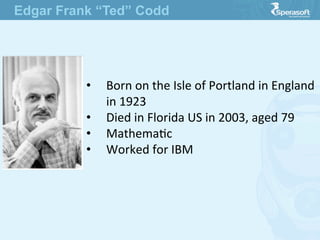



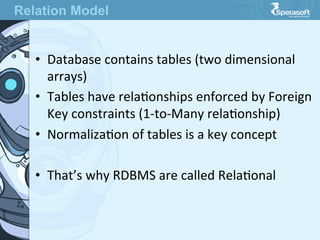
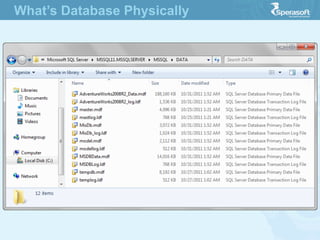

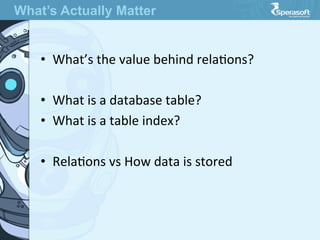



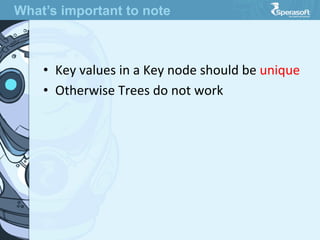
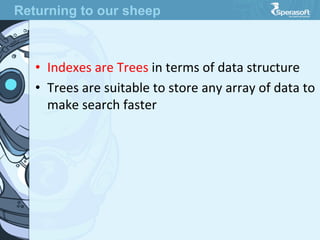


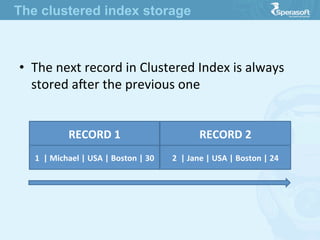
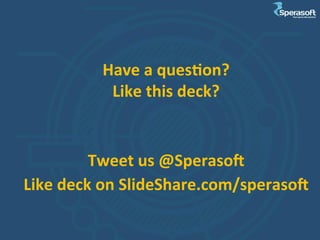

![• Unique and non-‐unique
• CREATE CLUSTERED INDEX [name] ON
[table_name] ([column1], [column2])
• CREATE UNIQUE CLUSTERED INDEX [name]
ON [table_name] ([column1], [column2])
Clustered Indexes](https://image.slidesharecdn.com/sperasofttalksdatabaseindexes-140711062011-phpapp02/85/Database-Indexes-24-320.jpg)
![• Unique and non-‐unique
• CREATE NONCLUSTERED INDEX [name] ON
[table_name] ([column1], [column2])
• CREATE UNIQUE NONCLUSTERED INDEX
[name] ON [table_name] ([column1],
[column2])
None Clustered Indexes](https://image.slidesharecdn.com/sperasofttalksdatabaseindexes-140711062011-phpapp02/85/Database-Indexes-25-320.jpg)






